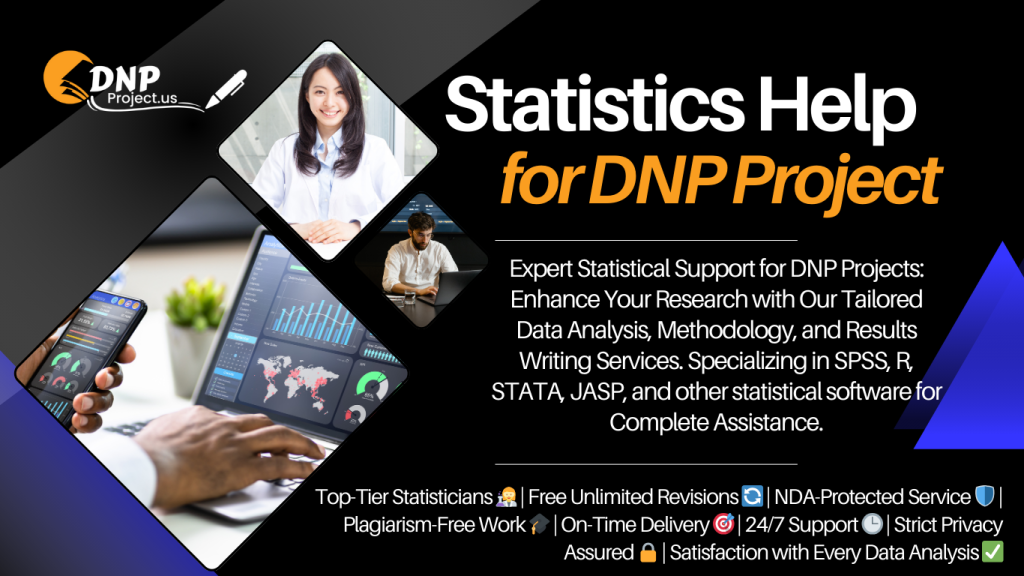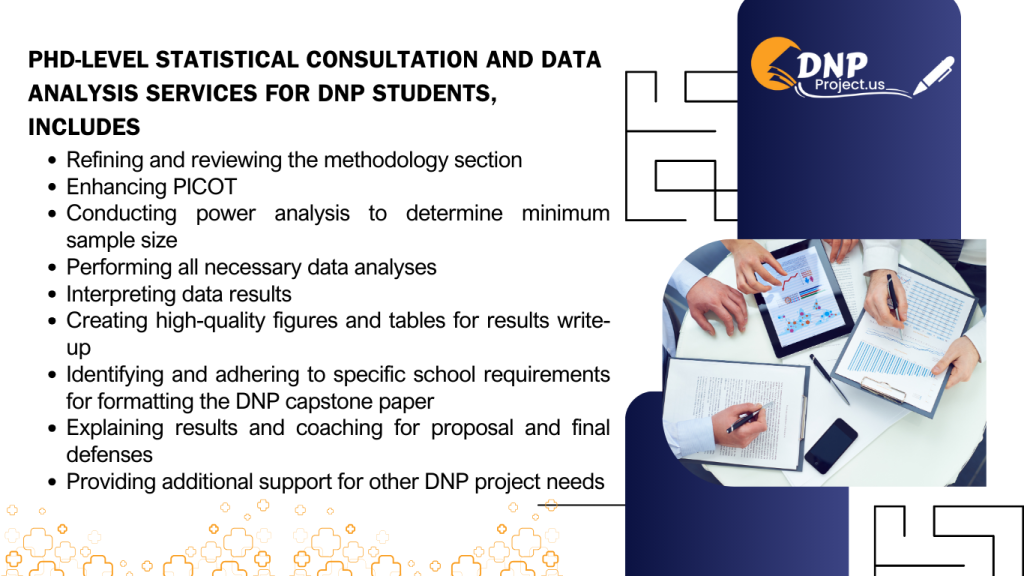Not sure what you need? Get Your DNP Capstone Project Help For An Affordable Price!

- DNP DATA ANALYSIS SERVICES
- Review of DNP Capstone project proposal
- Database management and variable codification
- Statistical methods
- Formal write-up of statistical methods
- Formal write-up of statistical results
- Formal write-up for tables/graphs
- Calculate diagnostic testing measures like sensitivity, specificity, positive predictive value (PPV), and negative predictive value (NPV) in Evidence based medicine.
- Apply epidemiological calculations like odds ratios, relative risk, number needed to treat (NNT), and number needed to harm (NNH) in Diagonistic testing

Our Unique Features
- Approx. 275 words/page
- Font: 12 point Arial/Times New Roman
- APA, MLA, Turabian/Chicago, Harvard, Vancouver format
- Verified DNP professionals Qualified and experienced real world DNP experts only
- FREE references page
- Free topic suggestions We Emphasize selecting understudied topics
- Free topic suggestions We Emphasize selecting understudied topics
Key Topics
Lorem ipsum dolor sit amet, consectetur adipiscing elit. Ut elit tellus, luctus nec ullamcorper mattis, pulvinar dapibus leo.

In the process of producing a DNP project, students collect primary data. To make such data usable students must conduct DNP data analysis. There are several reasons why students analyze data for their DNP projects. The first reason is to make the data manageable. Regrettably, working with voluminous data can be quite challenging. For this reason, it is advisable to condense them through analyzing them. Secondly, the process of working on a DNP project involves coming up with evidence, some of which must be in the form of analyzed data. Without analyzing the collected data, it can be quite difficult to design an evidence-based intervention that can deal with a certain issue of interest.
What is DNP data analysis?
Data analysis involves making sense of the collected primary data. Notably, this holds true even for DNP data. When analyzing DNP data, the goal is to come up with verifiable evidence that can help you design, implement and evaluate a nursing intervention. In most cases, DNP students have to analyze both qualitative and quantitative data. Generally, qualitative data are in textual form. This means that it is expressed in words that combine to form sentences. On the other hand, quantitative data are non-textual. Going in line with this, such data are expressed in the form of numbers. On this website, we have expert DNP data analysts who can assist you with analyzing both qualitative and quantitative data.

How we help students in overcoming different challenges related to conducting data analysis for DNP projects
- By guiding them in data cleaning
- Assisting such students in determining the right data analysis technique to use
- Helping students in using the various computer software available for analyzing data such as SPSS, NVivo and STATA, among others.
How to analyze qualitative data for DNP project
As discussed above, you may have to collect qualitative data when working on a DNP project. You can collect such data using data collection instruments such as; unstructured interview guides and unstructured interview schedules. Such instruments help DNP students to collect data that are textual in nature. When analyzing qualitative data, the goal is to identify the various themes in the collected data. Consequently, one of the most common methods of analyzing this data is thematic analysis techniques. The good news is that our experts who offer professional guidance with conducting DNP data analysis can assist you with using this famous technique.
Coding as an important step when analyzing qualitative data for a DNP project
Notably, while analyzing qualitative data for a DNP project, you have to code them at different levels. Coding such data is one of the effective ways of not only condensing qualitative data but also identifying different themes that emerge from them. The first main level of coding is referred to as open coding. During this stage of coding DNP students are supposed to condense the sentences and paragraphs from the qualitative data into fewer labels. During this stage, DNP students manage to effectively condense the qualitative data. By ordering our DNP project data analysis help, you will be able to effectively complete this stage of coding.
The axial level of coding qualitative data
Usually, this is the second level of coding. During this stage, you are supposed to figure out how different categories of coded data relate to one another. Essentially, during this level of coding, you are supposed to collapse the coded data into even fewer categories. As a result of this, DNP students are able to further condense the collected qualitative data during this stage. Remarkably, it is during this stage during qualitative data analysis that the various themes in the data begin to emerge. Sometimes completing this stage can be both confusing and time consuming. Therefore, it makes sense why a student might want to order DNP data analysis help. Such assistance is readily available on this website.
The last stage of coding qualitative data for a DNP project
During this last stage, you are supposed to give the entire analyzed qualitative data a single storyline. Notably, this level of coding is referred to as selective coding. To complete this stage, you need to carefully consider all the labels created after axial coding with the aim of finding what they share in common. A single storyline is important in giving a coherent explanation of the analyzed data. The good thing about allowing us to offer you DNP qualitative data analysis guidance is that we have what it takes to help you with completing this last stage. We will never disappoint you whenever you allow us to assist you with analyzing qualitative data.
Factors to keep in mind when analyzing qualitative data for a DNP project
It is important to keep several factors when analyzing DNP project qualitative data. One of such factors is the research questions or objectives of your DNP project. It is advisable to ensure that qualitative data analysis is centered on such elements of your DNP projects. Specifically, when analyzing data, you should aim at ensuring that you answer the research questions and meet the objectives of your DNP project. The second factor to think about when trying to make sense of qualitative data is the research problem under focus. After conducting DNP data analysis, you should be able to produce an evidence-based solution to the problem under focus. We are all set to assist you with analyzing qualitative data.
Conducting quantitative analysis of DNP data
The second set of data that you may have to work with when producing a DNP project is quantitative data. The quality that makes this type of data unique is that they are in the form of numbers. There are different types of data collection instruments that you can use to collect this kind of data. Some of the common instruments used to collect quantitative data are; structured questionnaires, structured interview schedules and structured observation schedules among others. Notably, surveys are the most common sources of quantitative data. Are you unsure about how to analyze the collected quantitative DNP data? If yes, then hiring DNP data analysts from this website would really serve you well.
Using Statistical techniques to analyze DNP quantitative data
Generally, there are different types of statistical techniques that one can use to analyze DNP data that are in quantitative form. It is worth starting by noting that the two types of statistics that DNP students can use to analyze quantitative data are descriptive and inferential ones. The purpose of descriptive statistics is to give a description of the sample that the DNP student used. For example, measures of central tendencies are among the common types of descriptive statistics. Secondly, descriptive statistics help DNP students in determining if the data are fit for a parametric test. If you are unsure of how to use descriptive statistics then you might want to order DNP data analysis on this site.
The use of inferential statistics when conducting DNP quantitative data analysis
Sometimes DNP students desire to generalize the results of their implemented DNP projects to the population from which they got the sample used. To enable them to accomplish this objective, such students must use inferential statistics when analyzing quantitative data. Such statistics allows DNP students to make inferences about the population where the sample has been drawn based on the results of the sample. Some of the common types of inferential statistics used include; chi-square, ANOVA, dependent t-test and independent t-test, among others. Making such complex statistical calculations is sometimes an uphill task. If you are facing such a predicament, then it would benefit you a great deal to order our help with analyzing DNP data.
How to go about the process of analyzing quantitative data for a DNP project
During the first stage of conducting DNP data analysis, you need to conduct data cleaning. Essentially, this involves confirming that you do not have missing data points, wrong data entries or ones that might distort your results by skewing them either positively or negatively. Most DNP students make the mistake of skipping this important stake of analyzing data. After cleaning data, you need to determine the purpose of analyzing such data. For instance, if you intend to test the relationship of data measured at nominal level then you can use Chi-square. If your intention is to measure differences between two unpaired samples then ought to use independent t tests or ANOVA if the unpaired samples are more than two.
Important factors to consider when analyzing quantitative data
There are different factors that you ought to take into consideration when conducting DNP project data analysis. One of such factors is the level of the measurement of the data. The second factor is independence of the sample. You should be sure to confirm if the samples are paired or unpaired. It is also good to assess whether the assumption of normal distribution of data holds true in relation to the available data so as you can know whether to use a parametric or non-parametric test. We assure you that our experts who help DNP students in analyzing quantitative data for their DNP students fully understand these important factors that one ought to consider before conducting data analysis.
Join our live chat or contact us for more information on how we can assist you to successfully complete your data analysis for your capstone project.
What our customers are saying:



DNP PROJECT WRITING Services
DNP assignment help
DNP capstone project help
Quality Improvement Project
Nursing Teaching Plan
MSN Assignment Writing Help
Nursing Assignment Help
Nursing Research Proposal
Nursing Research
DNP capstone project writing services
DNP evidence based practice project
Capstone proposal development
Best DNP capstone project writer
TERMS
Contact us:
1-917-619-9215
support@dnpproject.us

Disclaimer: Dnp capstone project writing service which provides custom written Dnp project papers inclusive of research material, for academic assistance purposes only. Dnp capstone project writing help must be used with proper reference.
